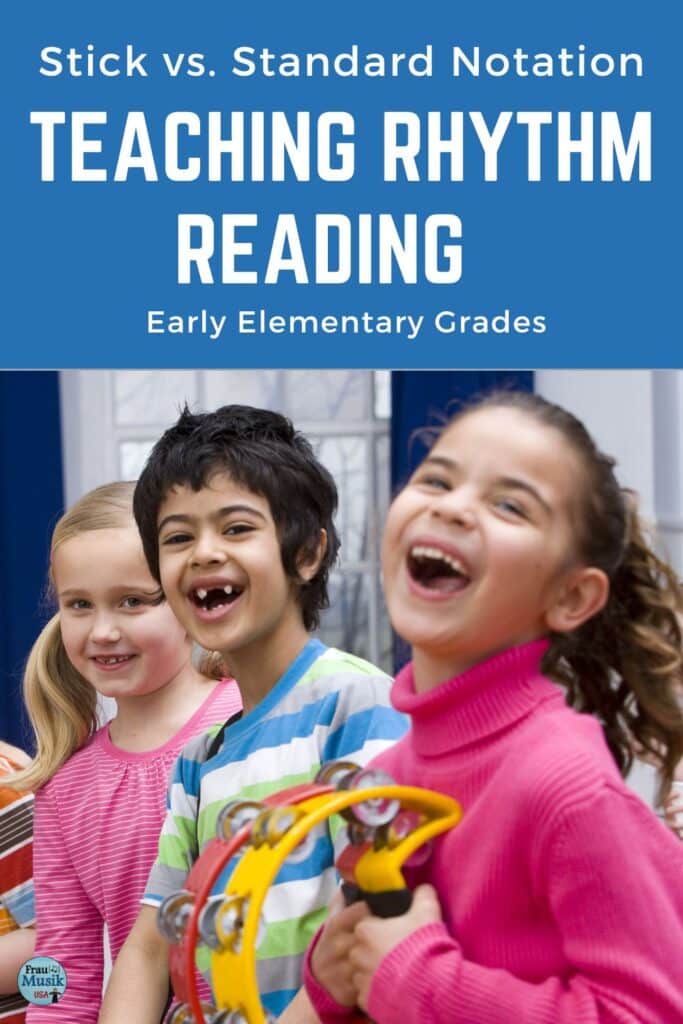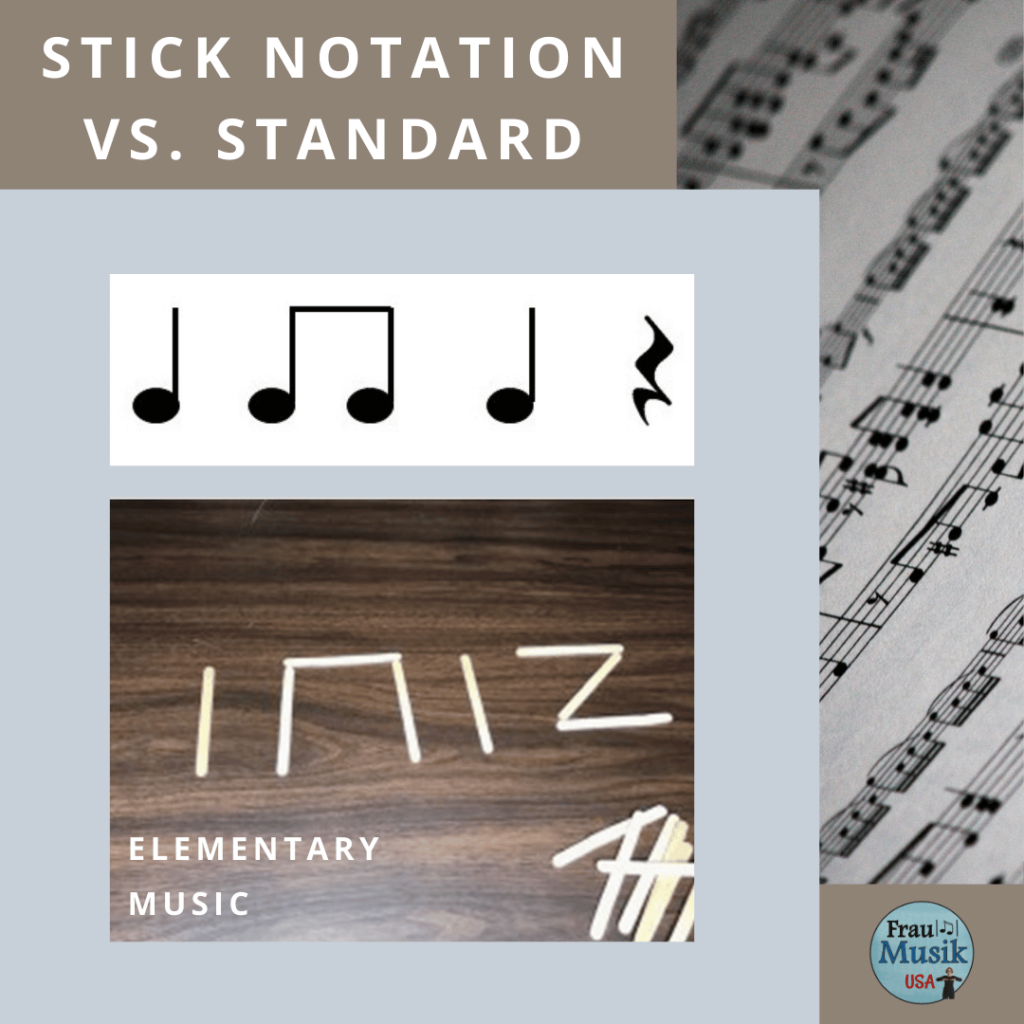Elementary Music Rhythm Reading – Standard Notation vs. Stick Notation
Elementary music teachers, are you considering starting your young students with standard notation instead of stick notation? See this post.
Some of the links on our site are affiliate links. If you click on a link and make a purchase, we may earn a small commission.
When you introduce rhythm reading in the elementary grades, which should you begin with – standard music notation or stick notation? Some music teachers want to turn this into a big debate, but it doesn’t have to be. Here is the short-cut version.
If you’re a busy music teacher without enough class time to get everything taught, start with standard notation. Young children can learn standard notation as easily as stick notation.
In fact, standard notation is quicker in the long run because there is no transition time. Take a peek at this Rhythm Reading Activity Bundle for the early elementary grades, beginning with iconic notation and leading straight to standard notation.

What’s in this post? Click to open the Table of Contents
Standard Notation vs. Stick Notation – The Back Story
When I graduated from college I imagined I would teach middle school and high school band for my entire career. After teaching in my first band position for only 1 1/2 years, my husband got a new job 250 miles away and I had become pregnant with our first child.
With a new baby, a band director career was not in the cards for me. It was also evident I was not well prepared to teach at the elementary level (although no one except me seemed to notice).
When I was offered a part-time position teaching elementary music, I gladly accepted. The position was 5/8 time and was perfect for a new mom. Because the position was over half-time, I received health insurance benefits but I was not teaching a full load.
The Kodály Method
When a local college began offering Kodály certification courses I jumped in with both feet. The timing was perfect as I had finished my Masters degree but still didn’t feel prepared to teach young children. I embraced the Kodály method wholeheartedly following every step and all the techniques I had been taught while implementing the lessons in my elementary music classrooms.
The year our second child went to kindergarten was the year I switched schools and returned to full-time music teaching. And year after year I felt the pressure to teach more with less and less time.
I dropped stick notation and redesigned my teaching materials to begin with iconic notation which led to straight to standard notation. My students learned quickly and the progress we made was noticed by parents, administrators, and other teachers.
(This does NOT mean I skipped the Kodály “prepare” phase of introducing each element aurally. It means when I introduced the notes visually, I used standard notation instead of stick notation.)
I felt guilty about this deviation from what I had been taught. I only told some of my closest music teacher friends. Then, I heard a nationally-known, well-respected music educator/presenter say she had been starting her early elementary kids reading standard notation for years.
Finally, I felt like I was validated. I did not have to hide in the shadows anymore.
Standard Notation vs. Stick Notation Rationale
My rationale for starting with standard notation is as follows.
I began to identify correlations between how we teach young children to read language and learning to read music. This analogy is a little weird but “stick” with me. (No pun intended. 😊)
When we teach young children the letters of the alphabet (the building blocks of written language) we don’t teach that two parallel lines | | is an H and then later say, oh, this is really an H. You must connect those two vertical lines with a horizontal line to make an “H”.

In fact, when teaching the alphabet, we teach the uppercase and lowercase letters at the same time – H h. As music teachers, we don’t have to oversimplify the music reading process. Children are capable of learning standard notation from the start. And, this effort to oversimplify can actually complicate things in the long run.
Students Learn Standard Notation as Quick at Stick Notation
You may have heard the argument that starting with stick notation helps students better discriminate between quarter notes and eighth notes. I have found no difference. When presented correctly, young children identify and read standard notation as quickly as stick notation.
I have found children recognize and read half notes quicker when they begin reading music with standard notation. They’re not so focused on the note stem and beams. They see the notes more as a “whole” complete symbol.
And when you begin with standard notation, you eliminate the transition period when you move from stick to standard notation. This approach saves time.
Popsicle Stick Dictation
This doesn’t mean you won’t ever use stick notation. Popsicle dictation is one of my favorite activities. Children easily figure out how to represent notes with popsicle sticks. And, I like to do rhythmic dictation with pretzels and Skittles at the end of the year. Yum!
Real-World Music Symbols
When young students begin to read standard music notation, they “find” music notation in their environment. Children see the music notes in a hymnal or songbook at church. They see a parent’s or older sibling’s band or choir music and they’re excited to see notes they can read.
A positive side effect of teaching standard notation is it raises music advocacy. When parents, other teachers, and administrators see children reading “real” music they become more supportive of your music program.
See this post for more – Increase Music Advocacy by Developing Music Literacy.
Standard Notation or Stick Notation, What Do You Choose?
You will have to make your own decision whether you’ll start your early elementary students with standard notation or stick notation. Every teacher and every elementary school is different.
But, creating all of your own materials is time-consuming. If you’re looking for no-prep music reading lessons that use icons and standard notation and are non-rhythm syllable specific, take a peek at these Music Literacy Activity Bundles.
Standard notation vs. stick notation is not a big deal no matter which you choose.
Need a Lesson to Use as a Model? Pick Up This Free Resource
Pick up a FREE So, La, Mi Music Reading Lesson when you subscribe to our email list. Then, watch your inbox for more ideas, tips, techniques, and free resources heading your way.
Meet the Author
Terri Lloyd is a former elementary music teacher with over 25 years of experience. She holds a Bachelor of Music, a Master of Science in Education, and a Technology Certificate in Instructional Design.
Terri is active in music education through blogging, presenting and attending workshops, and curriculum development. She serves on the music staff at her church and volunteers for an after-school children’s program. Terri is an active musician in the community, performing in a local Big Band, pit orchestras, and various events.
3 Comments
Comments are closed.